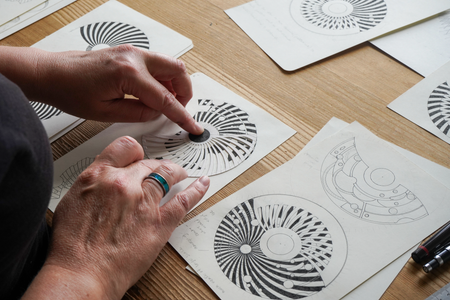The terms “automatic” and “manual wind” refer to how the power is transferred to the mainspring in the first place. How this happens in a manual wind is pretty obvious. You turn the crown, which in turn winds up the mainspring, and, using a ratchet, the spring is kept wound and prevented from unwinding, except by transferring power to the escapement.
In an automatic watch, there is a weighted rotor attached to a central pivot. When the watch is worn, gravity causes the rotor to move one way or another. Using a system of gears, this power is transferred to the mainspring within the barrel. Accordingly, the term automatic refers to the fact that the watch winds automatically, using the movement of the wearers’ wrist.
Now to most of the modern world, the choice between an automatic and manual wind would sound like a no-brainer. Why on earth would I want a watch that I have to wind myself every day, when I can get one that winds itself automatically? However, for some people it’s not that simple. To explain I’ll first go through some of the pros and cons of automatic vs manual wind movements.
In terms of manual wind watches, because they have significantly fewer components and moving parts, compared to an automatic, there is a less that can go wrong. This is one reason why when mechanical military watches were issued, they were almost all hand wind, as in the longer term they are less likely to need any kind of service compared to an automatic. In automatic watches it is common for the rotor bearings, and winding gears to be replaced routinely during a service, due to wear, after 5 – 10 years of everyday use.
However, the fact that the mainspring of a manual wind movement is not kept under the same constant tension throughout the day, as is usually the case in an automatic, (which is constantly topping up the power), can mean there is slightly more variability in the accuracy of a manual wind watch compared to an automatic.
When a watch gets close to the end of its power reserve, it has a propensity to slow down slightly. Conversely, when just wound, it can run very slightly faster. However, in real life applications, so long as you wind your watch at about the same time every day, there will be little or no observable difference between the accuracy of an automatic and manual wind movement.
When it comes to automatic movements, there is obviously the convenience of not having to remember to wind your watch every day. There can also be a pleasing aesthetic effect with a display case back where you can see the rotor spin around in circles. However, some would argue it is more pleasing to see the full movement of a manual wind movement without half of it covered by the rotor!
However, the reasons people choose the objects that populate their daily lives are often about more than just technical performance or convenience. Some people drive automatic cars because they value the ease and convenience that not having to change gears provide. Others prefer manual cars, with the feeling of direct engagement with the machine, and perhaps a sense of greater control. The same sorts of feelings also come into play when it comes to choosing a manual or automatic movement.
In todays digitally connected world, where everything happens automatically at the speed of light, it can be novel and relaxing to gently wind your watch every day. A little moment of quiet ritual, which can lead the more philosophically minded to consider the nature of life and existence. It also provides a sense of connection and meaning to your watch, for to keep running, it is entirely dependent on you to “feed” it by winding it every day. This sense of feeding a living thing is reinforced when you see its little “heart” (also known as balance wheel) beating thanks to your input. In much the same way that people are rediscovering the joy of vinyl records, compared with digital music, the same can be said about hand wind watches.
However, if the above paragraph makes you cringe, and you find yourself screaming “it’s just a watch, not a Tamagotchi!” you may be an automatic kind of person. The automatic movement relentlessly, and silently winding your watch every day as your wear it, without further intervention from the outside world, means it just works, day in and day out.
So, the choice is yours automatic or hand wind. Whichever one you choose, it going to be a winner compared to the soullessness of Quartz!






